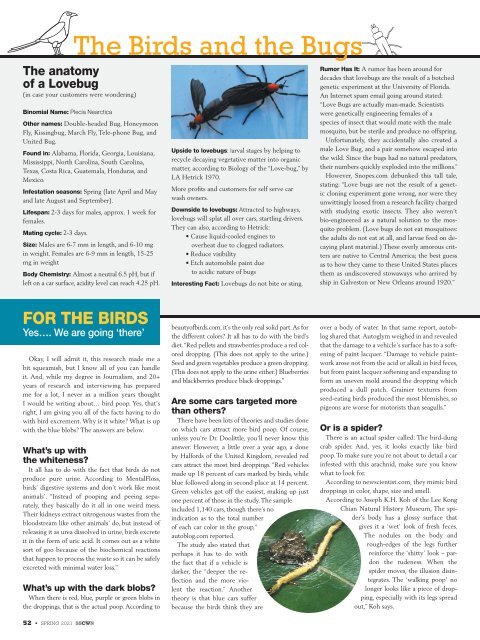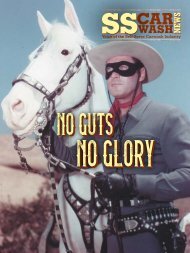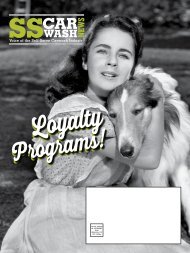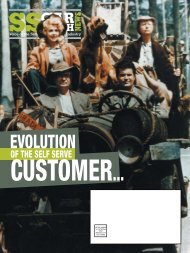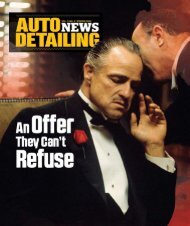Create successful ePaper yourself
Turn your PDF publications into a flip-book with our unique Google optimized e-Paper software.
The Birds and the Bugs<br />
The anatomy<br />
of a Lovebug<br />
(in case your customers were wondering)<br />
Binomial Name: Plecia Nearctica<br />
Other names: Double-headed Bug, Honeymoon<br />
Fly, Kissingbug, March Fly, Tele-phone Bug, and<br />
United Bug.<br />
Found in: Alabama, Florida, Georgia, Louisiana,<br />
Mississippi, North Carolina, South Carolina,<br />
Texas, Costa Rica, Guatemala, Honduras, and<br />
Mexico.<br />
Infestation seasons: Spring (late April and May<br />
and late August and September).<br />
Lifespan: 2-3 days for males, approx. 1 week for<br />
females.<br />
Mating cycle: 2-3 days.<br />
Size: Males are 6-7 mm in length, and 6-10 mg<br />
in weight. Females are 6-9 mm in length, 15-25<br />
mg in weight<br />
Body Chemistry: Almost a neutral 6.5 pH, but if<br />
left on a car surface, acidity level can reach 4.25 pH.<br />
Upside to lovebugs: larval stages by helping to<br />
recycle decaying vegetative matter into organic<br />
matter, according to Biology of the “Love-bug,” by<br />
LA Hetrick 1970.<br />
More profits and customers for self serve car<br />
wash owners.<br />
Downside to lovebugs: Attracted to highways,<br />
lovebugs will splat all over cars, startling drivers.<br />
They can also, according to Hetrick:<br />
• Cause liquid-cooled engines to<br />
overheat due to clogged radiators.<br />
• Reduce visibility<br />
• Etch automobile paint due<br />
to acidic nature of bugs<br />
Interesting Fact: Lovebugs do not bite or sting.<br />
Rumor Has It: A rumor has been around for<br />
decades that lovebugs are the result of a botched<br />
genetic experiment at the University of Florida.<br />
An Internet spam email going around stated:<br />
“Love Bugs are actually man-made. Scientists<br />
were genetically engineering females of a<br />
species of insect that would mate with the male<br />
mosquito, but be sterile and produce no offspring.<br />
Unfortunately, they accidentally also created a<br />
male Love Bug, and a pair somehow escaped into<br />
the wild. Since the bugs had no natural predators,<br />
their numbers quickly exploded into the millions.”<br />
However, Snopes.com debunked this tall tale,<br />
stating: “Love bugs are not the result of a genetic<br />
cloning experiment gone wrong, nor were they<br />
unwittingly loosed from a research facility charged<br />
with studying exotic insects. They also weren’t<br />
bio-engineered as a natural solution to the mosquito<br />
problem. (Love bugs do not eat mosquitoes:<br />
the adults do not eat at all, and larvae feed on decaying<br />
plant material.) These overly amorous critters<br />
are native to Central America; the best guess<br />
as to how they came to these United States places<br />
them as undiscovered stowaways who arrived by<br />
ship in Galveston or New Orleans around 1920.”<br />
FOR THE BIRDS<br />
Yes…. We are going ‘there’<br />
Okay, I will admit it, this research made me a<br />
bit squeamish, but I know all of you can handle<br />
it. And, while my degree in Journalism, and 20+<br />
years of research and interviewing has prepared<br />
me for a lot, I never in a million years thought<br />
I would be writing about… bird poop. Yes, that’s<br />
right, I am giving you all of the facts having to do<br />
with bird excrement. Why is it white? What is up<br />
with the blue blobs? The answers are below.<br />
What’s up with<br />
the whiteness?<br />
It all has to do with the fact that birds do not<br />
produce pure urine. According to MentalFloss,<br />
birds’ digestive systems and don’t work like most<br />
animals’. “Instead of pooping and peeing separately,<br />
they basically do it all in one weird mess.<br />
Their kidneys extract nitrogenous wastes from the<br />
bloodstream like other animals’ do, but instead of<br />
releasing it as urea dissolved in urine, birds excrete<br />
it in the form of uric acid. It comes out as a white<br />
sort of goo because of the biochemical reactions<br />
that happen to process the waste so it can be safely<br />
excreted with minimal water loss.”<br />
What’s up with the dark blobs?<br />
When there is red, blue, purple or green blobs in<br />
the droppings, that is the actual poop. According to<br />
beautyofbirds.com, it’s the only real solid part. As for<br />
the different colors? It all has to do with the bird’s<br />
diet. “Red pellets and strawberries produce a red colored<br />
dropping. (This does not apply to the urine.)<br />
Seed and green vegetables produce a green dropping.<br />
(This does not apply to the urine either.) Blueberries<br />
and blackberries produce black droppings.”<br />
Are some cars targeted more<br />
than others?<br />
There have been lots of theories and studies done<br />
on which cars attract more bird poop. Of course,<br />
unless you’re Dr. Doolittle, you’ll never know this<br />
answer. However, a little over a year ago, a done<br />
by Halfords of the United Kingdom, revealed red<br />
cars attract the most bird droppings. “Red vehicles<br />
made up 18 percent of cars marked by birds, while<br />
blue followed along in second place at 14 percent.<br />
Green vehicles got off the easiest, making up just<br />
one percent of those in the study. The sample<br />
included 1,140 cars, though there’s no<br />
indication as to the total number<br />
of each car color in the group,”<br />
autoblog.com reported.<br />
The study also stated that<br />
perhaps it has to do with<br />
the fact that if a vehicle is<br />
darker, the “deeper the reflection<br />
and the more violent<br />
the reaction.” Another<br />
theory is that blue cars suffer<br />
because the birds think they are<br />
over a body of water. In that same report, autoblog<br />
shared that Autoglym weighed in and revealed<br />
that the damage to a vehicle’s surface has to a softening<br />
of paint lacquer. “Damage to vehicle paintwork<br />
arose not from the acid or alkali in bird feces,<br />
but from paint lacquer softening and expanding to<br />
form an uneven mold around the dropping which<br />
produced a dull patch. Grainier textures from<br />
seed-eating birds produced the most blemishes, so<br />
pigeons are worse for motorists than seagulls.”<br />
Or is a spider?<br />
There is an actual spider called: The bird-dung<br />
crab spider. And, yes, it looks exactly like bird<br />
poop. To make sure you’re not about to detail a car<br />
infested with this arachnid, make sure you know<br />
what to look for.<br />
According to newscientist.com, they mimic bird<br />
droppings in color, shape, size and smell.<br />
According to Joseph K.H. Koh of the Lee Kong<br />
Chian Natural History Museum, The spider’s<br />
body has a glossy surface that<br />
gives it a ‘wet’ look of fresh feces.<br />
The nodules on the body and<br />
rough-edges of the legs further<br />
reinforce the ‘shitty’ look – pardon<br />
the rudeness. When the<br />
spider moves, the illusion disintegrates.<br />
The ‘walking poop’ no<br />
longer looks like a piece of dropping,<br />
especially with its legs spread<br />
out,” Koh says.<br />
52 • SPRING 2021


